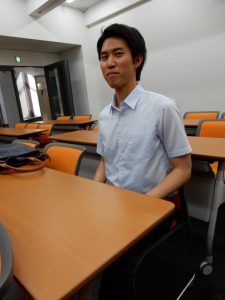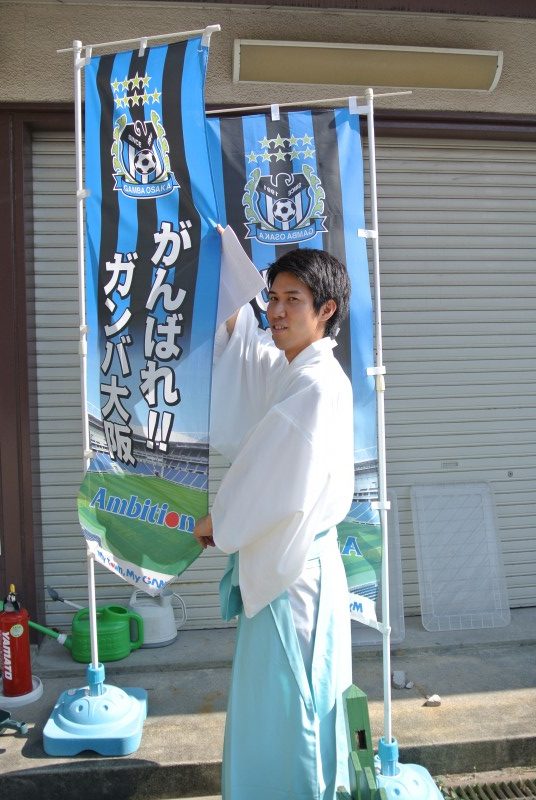Taishi Kato is a young Shinto priest with an interest in spreading knowledge of the religion to overseas people, and Green Shinto carried an interview with him last year before he went to study for an MA at the School of Oriental and African Studies in London (see here).
He has recently returned to Japan, so we were naturally curious to find out about his experiences during his time abroad, and how was the response to his role as a Shinto priest (he is the son of the Guji (head priest) of Hattori Tenjingu in Osaka).
*************

Taishi in student mode, prior to leaving for England
Did you find much interest in Shinto? If so, from what kind of people?
Yes. I made a lot of friends who are interested in Shinto. To be honest, I did not even expect that so many foreign people have a profound knowledge of Shinto. I could learn different perspectives of Shinto from them. For instance, those who do Martial Arts. Their understanding is based on their sensitivities so that I could share the view of Shinto not based on rational thought but intuitive perception. I would like to learn more about the view of Shinto from those who are living outside Japan.
What did you find was the most difficult part in explaining Shinto to people in Britain?
I felt the difficulty for explaining about the essence of Shinto in Europe in the framework “religion”. For example, I think that Japanese are confused about answers when asked “What is your religion?” There is a prerequisite in this question that a person “belongs to one religion as a believer”. However, in Shinto human beings cannot decide who is a Shinto believer or not. Shinto has no absolute doctrine and sacred scriptures, while Shinto has evolved through the centuries by incorporating a great number of concepts and ideas from Buddhism, Confucianism and Daoism.Instead of drawing boundaries, Shinto has coexisted with other religions. Given this characteristic of Shinto, it is very different from the concept of religion in the West. Therefore, I struggled to explain about the concepts of Shinto within the framework of “religion”. However, even if one’s religion or nationality is different, by sharing “thankfulness for being alive now”, I believe that people will change to the feeling that we are alive thanks to everything around us rather than the feeling that emphasizes the difference between “us and others”.
How about your experiences in the rest of Europe, outside Britain?
I was invited to a Japanese cultural event at the Davos Congress Center in Switzerland. I gave a talk on Shinto in English. After that, I also offered a prayer for the success of the event. Swiss people attended the ceremony with deep respect for Japanese traditional culture,
I had a sense that I could become one with attendants spiritually through the ceremony. If given an opportunity, I would like to perform the ceremony again.

Taishi in his priestly garb, with a flag supporting the local Osaka football team
What was the best experience (or biggest challenge) you had in your time in Britain?
One of my best experiences was to share Japanese traditional culture with foreigners. Japanese people have potentially shared the traditional sensitivity of being alive thanks to everything around us. For instance, in Japan, there is a custom of joining one’s hands together before eating in order to express one’s gratitude. It is easy to take food and the process of eating for granted. However, Japanese appreciate the effort of the many people who harvested, transported, stored and sold the food. Moreover, natural energy, such as sun, rain, soil and microorganisms have been regarded as core elements for our eating. I was so delighted to share the idea of “being alive thanks to everything around us” by joining our hands together before eating a meal with foreigners.
What are your plans for the future, now that you are back in Japan?
I would like to provide an opportunity for visitors of my Shinto shrine to hear about Shinto. There are few opportunities for foreigners to know what Shinto is within a shrine. When I was in Britain, I realised that I could broaden my view of Shinto through conversation with foreigners. Therefore, our Shinto shrine will start giving an opportunity for visitors to discuss about Shinto. I believe that it will be helpful to make our connection stronger through Shinto. And also if possible, I would like to perform ceremonies outside Japan.

Hello John, Which book would you recommend as a good introduction to Shintoisme?
Thanks for your help and your amazing blog.
Best wishes from London
Christine
Good day, Christine… Thank you for the enquiry. There are several books on the market nowadays, so it depends what angle you are looking for – academic, orthodox, sectarian, historical, practical, traditional, revisionist… For a general introduction, there are many places on the internet though not all can be trusted as reliable, so please check the authority of the writer or website. Otherwise please click on the Further Reading button at the top of the Green Shinto page. Alternatively, browse through the reviews in the Books category in the righthand column.
An excellent interview John. As I commented on Facebook, I really like what Kato-san said about “Being alive thanks to everything around us”. His outreach to foreigners is commendable and important. I was wondering what would be the best way to contact Kato-san? I plan to visit Hattori Tenjingu when I return to Japan in April 2018. If it was possible to organise a meeting in advance that would be perfect. From memory the Shrine includes the twelve zodiac animals. That makes it of additional interest for my exploration of the elements in Japan. It would be enlightening to speak to Kato-san about these and other aspects of Shinto in relation to the elements.
Hi Jann, thanks for the feedback. I don’t recall the twelve zodiac animals at the shrine, though the Seven Lucky Deities feature in the form of Ebisu. not sure about the Five Elements either, though the (Buddhist) incense holder might warrant investigation for wood, fire, earth, metal and…